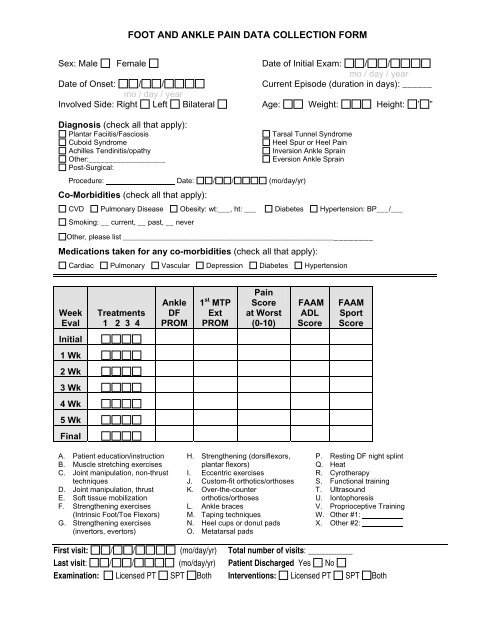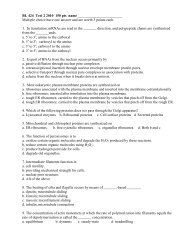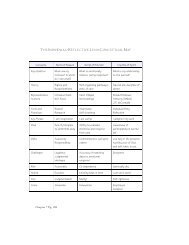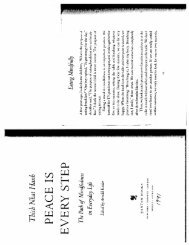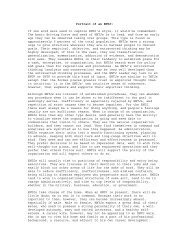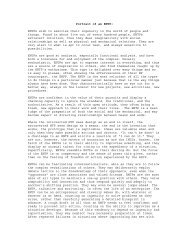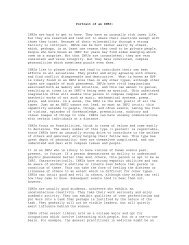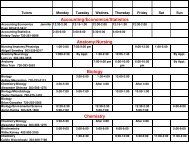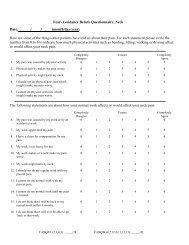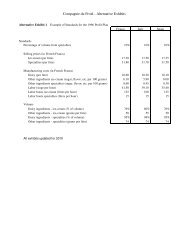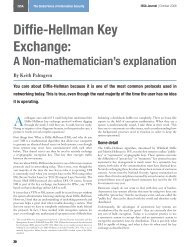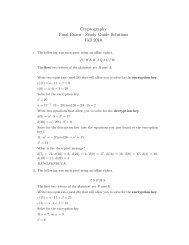FOOT AND ANKLE PAIN DATA COLLECTION FORM - Regis
FOOT AND ANKLE PAIN DATA COLLECTION FORM - Regis
FOOT AND ANKLE PAIN DATA COLLECTION FORM - Regis
Create successful ePaper yourself
Turn your PDF publications into a flip-book with our unique Google optimized e-Paper software.
<strong>FOOT</strong> <strong>AND</strong> <strong>ANKLE</strong> <strong>PAIN</strong> <strong>DATA</strong> <strong>COLLECTION</strong> <strong>FORM</strong><br />
Sex: Male Female Date of Initial Exam: / /<br />
mo / day / year<br />
Date of Onset: / / Current Episode (duration in days): ______<br />
mo / day / year<br />
Involved Side: Right Left Bilateral Age: Weight: Height: ’ ”<br />
Diagnosis (check all that apply):<br />
Plantar Faciitis/Fasciosis Tarsal Tunnel Syndrome<br />
Cuboid Syndrome Heel Spur or Heel Pain<br />
Achilles Tendinitis/opathy Inversion Ankle Sprain<br />
Other:___________________<br />
Post-Surgical:<br />
Eversion Ankle Sprain<br />
Procedure: Date: / / (mo/day/yr)<br />
Co-Morbidities (check all that apply):<br />
CVD Pulmonary Disease Obesity: wt:___, ht: ___ Diabetes Hypertension: BP___/___<br />
Smoking: __ current, __ past, __ never<br />
Other, please list ____________________________________________________________<br />
Medications taken for any co-morbidities (check all that apply):<br />
Cardiac Pulmonary Vascular Depression Diabetes Hypertension<br />
Week<br />
Eval<br />
Initial<br />
1 Wk<br />
2 Wk<br />
3 Wk<br />
4 Wk<br />
5 Wk<br />
Final<br />
Treatments<br />
1 2 3 4<br />
A. Patient education/instruction<br />
B. Muscle stretching exercises<br />
C. Joint manipulation, non-thrust<br />
techniques<br />
D. Joint manipulation, thrust<br />
E. Soft tissue mobilization<br />
F. Strengthening exercises<br />
(Intrinsic Foot/Toe Flexors)<br />
G. Strengthening exercises<br />
(invertors, evertors)<br />
Ankle<br />
DF<br />
PROM<br />
1 st MTP<br />
Ext<br />
PROM<br />
Pain<br />
Score<br />
at Worst<br />
(0-10)<br />
H. Strengthening (dorsiflexors,<br />
plantar flexors)<br />
I. Eccentric exercises<br />
J. Custom-fit orthotics/orthoses<br />
K. Over-the-counter<br />
orthotics/orthoses<br />
L. Ankle braces<br />
M. Taping techniques<br />
N. Heel cups or donut pads<br />
O. Metatarsal pads<br />
FAAM<br />
ADL<br />
Score<br />
FAAM<br />
Sport<br />
Score<br />
P. Resting DF night splint<br />
Q. Heat<br />
R. Cyrotherapy<br />
S. Functional training<br />
T. Ultrasound<br />
U. Iontophoresis<br />
V. Proprioceptive Training<br />
W. Other #1:<br />
X. Other #2:<br />
First visit: / / (mo/day/yr) Total number of visits: ___________<br />
Last visit: / / (mo/day/yr) Patient Discharged Yes No<br />
Examination: Licensed PT SPT Both Interventions: Licensed PT SPT Both
<strong>FOOT</strong> <strong>AND</strong> <strong>ANKLE</strong> <strong>PAIN</strong> <strong>DATA</strong> <strong>COLLECTION</strong> <strong>FORM</strong><br />
Demographic Data<br />
Dates: For all dates, use the format MM / DD / YYYY with a "0" in the first box if the month or day is a single<br />
digit. For the "date of symptom onset," if the patient cannot recall an exact or approximate onset, use the first<br />
day of the month when the symptoms began. If the patient cannot recall the month, use 01 / 01 / YYYY.<br />
Weight/Height: Fill in the patient’s weight and height with their shoes off, measured in pounds and<br />
feet/inches, respectively. If you are unable to measure the patient’s weight and/or height, leave this area<br />
blank.<br />
Sex: Shade in the appropriate circle.<br />
Involved Side: Shade in the appropriate circle, if both feet are involved, check the ‘bilateral’ category and<br />
also check the box for the LE that you are recording measurements for. For example, if the patient has<br />
bilateral foot and/or ankle symptoms, and you decide to record data for the left foot, then you would check<br />
both bilateral and left.<br />
Diagnosis: Check any diagnosis that applies to the patient. More than one option may be selected. If the<br />
patient has had surgery for the condition, indicate the type of procedure and date.<br />
Co-Morbidities: Check all co-morbidities that apply to the patient. More than one option may be selected. If<br />
the patient has other co-morbidities than the types given, please check other and list them in the space<br />
provided.<br />
Medications taken for any co-morbidities: Check boxes of the co-morbidities that the patient is currently<br />
taking medication for.<br />
Clinical Data<br />
The data is set up to record at weekly intervals for the first six weeks of therapy (initial, 5 follow-ups, and<br />
discharge). Each row of data represents a given week. If the patient is seen somewhere in the interval, round<br />
up to the higher week number. If the patient is not seen during a given week, leave that row empty and fill in<br />
all other available data. If the patient is seen twice or three times in one week, use the latest visit in the data<br />
for that week. If both LE are involved, use the data from the more involved foot and ankle.<br />
Treatments: For each week, choose from the list labeled A-x, the four major treatments used during that<br />
week. When more than four of the treatments are used, list the four of highest priority according to the<br />
therapist's opinion of those treatments that have most influence on the patient's recovery. Use the ‘other’<br />
category to identify interventions that are not list, then list the intervention in the space provided.<br />
Interventions Chosen By: Please indicate who selected the interventions or if it was a combined effort.<br />
Ankle dorsiflexion passive range of motion (DF PROM): Position the patient in supine with the legs fully<br />
extended. While keeping the patient's ankle in subtalar neutral passively dorsiflex the patient's ankle through<br />
the maximum range of ankle dorsiflexion. Align the stationary arm of the goniometer with the fibular head and<br />
the moving arm parallel to the lateral order of the calcaneus. The PROM value is recorded as positive (+)<br />
when the ROM is beyond neutral (0 degrees). Record the value as a negative (-) when the ROM does not<br />
reach neutral. The appropriate sign should be placed in the first space followed by the range of motion on the<br />
goniometer.<br />
Great toe MTP Extension (Ext) PROM: With the ankle maintained in neutral, passively extend the patient's<br />
great toe through the maximum range of available motion. Align the stationary arm with the midline of the first<br />
metatarsal. Align the moving arm with the midline of the proximal phalanx of the great toe. Record the value<br />
as described for ankle DF PROM.<br />
Pain Score at Worst: Ask the patient to rate his or her worst pain in the last 24 hours using a pain rating<br />
scale of 0-10 ("0" meaning no pain, "10" meaning the worst pain imaginable). Whole digits are recorded only.<br />
FAAM: This self-report questionnaire is specific to the foot and ankle region in regard to ADL’s and sports<br />
activities. There are separate scores for ADL’s and the sport scale and the items are scored the same. Each<br />
item is given a point value as follows: No difficulty at all=4, slight difficulty=3, moderate difficulty=2, extreme<br />
difficulty=1, and unable to do=0. If items are left blank or marked as N/A, the total possible points are reduced<br />
by 4 for each blank item. Higher scores indicate higher levels of physical functioning.<br />
ADL Score: There are 21 items in this section. If all 21 items are completed, add the scores for each<br />
item and divide by 84 (total number of points possible) to compute the percentage score. The<br />
percentage score is rounded to the nearest whole number and recorded.<br />
Sport Score: This is an 8 item subscale of the FAAM. If all 8 items are completed, add the scores for<br />
each item and divide by 32 (total number of points possible) to compute the percentage score. The<br />
percentage score is rounded to the nearest whole number and recorded.


